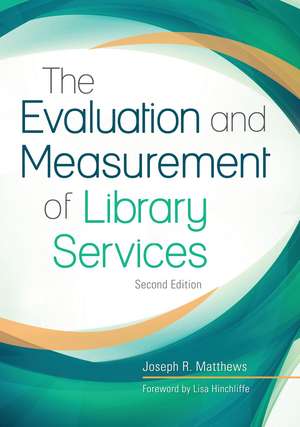The Evaluation and Measurement of Library Services
Autor Joseph R. Matthews Cuvânt înainte de Lisa Hinchliffeen Limba Engleză Paperback – 26 oct 2017 – vârsta până la 17 ani
Preț: 349.90 lei
Preț vechi: 524.42 lei
-33% Nou
Puncte Express: 525
Preț estimativ în valută:
66.96€ • 69.82$ • 55.65£
66.96€ • 69.82$ • 55.65£
Carte tipărită la comandă
Livrare economică 21 martie-04 aprilie
Preluare comenzi: 021 569.72.76
Specificații
ISBN-13: 9781440855368
ISBN-10: 1440855366
Pagini: 480
Dimensiuni: 178 x 254 mm
Greutate: 1 kg
Ediția:2
Editura: Bloomsbury Publishing
Colecția Libraries Unlimited
Locul publicării:New York, United States
ISBN-10: 1440855366
Pagini: 480
Dimensiuni: 178 x 254 mm
Greutate: 1 kg
Ediția:2
Editura: Bloomsbury Publishing
Colecția Libraries Unlimited
Locul publicării:New York, United States
Caracteristici
Explains the most effective ways of conducting library measurement and evaluation, covering qualitative and quantitative tools, data analysis, and specific methodologies for measuring and assessing specific services
Notă biografică
Joseph R. Matthews is president of JRM Consulting and has provided consulting assistance to numerous academic, public, and special libraries and local governments. He is editor of Public Library Quarterly and is on the editorial boards of Performance Measurement and Metrics and Library Hi Tech.
Cuprins
ForewordAcknowledgmentsIntroductionPart I Evaluation: Process and ModelsChapter 1: Evaluation IssuesWho DecidesAn Evaluation Action PlanIdentifying the ProblemDetermining the Scope of the AnalysisDetermining Whether the Answer Already ExistsDetermining the Kind of Analysis to DoDeciding What Data Will Be NeededConducting the Analysis and Preparing a ReportUsing the Results for Service Improvement: The Feedback LoopObstacles to EvaluationEthics of EvaluationPhilosophical QuestionNotesChapter 2: Evaluation ModelsEvaluation ModelsOther Notable ModelsLimitationsSummaryNotesPart II Methodology ConcernsChapter 3: Qualitative ToolsNo ContactExamining DocumentsDiariesOne-to-One InteractionObservationInterviewingGrounded TheoryThink Aloud/Think After Verbal ProtocolEthnographic MethodsNetnographic MethodsPhenomenographyGroup InteractionFocus GroupsDelphi MethodCritical Incident TechniqueConcept MappingAnalysis of Qualitative DataPresentation of FindingsSummaryNotesChapter 4: Quantitative ToolsCountingMeasuringSurveysTypes of QuestionsForm of QuestionsQuestion ConstructionDistributing the SurveyTypes of SamplingDetermining Sample SizeSurvey NonresponseCaveatsConjoint AnalysisTransaction Log AnalysisExperimentsSummaryNotesChapter 5: Analysis of DataDescriptive Statistics TechniquesThermometer ChartHistogramFrequency PolygonBar ChartsLine ChartsPie ChartsMeasures of Central TendencyThe ModeThe MedianThe MeanA Distribution's ShapeMeasures of VariabilityRangePercentilesStandard DeviationInferential StatisticsVisualizationMeta-AnalysisSummaryNotesPart III Evaluation of Library OperationsChapter 6: Evaluation of OperationsBenchmarkingAcademic Library StatisticsPublic Library StatisticsActivity-Based CostingStep 1-Identify Key Activities and Relevant Cost DriversStep 2-Allocate Staff Time to ActivitiesStep 3-Attribute Staff Salaries and Other Costs to Activity Cost PoolsStep 4-Determine Cost Per Cost DriverCost-Benefit AnalysisLean ToolsStatistical Process ControlSummaryNotesChapter 7: Evaluation of Technical ServicesService DefinitionEvaluation QuestionsIntroductionEvaluation MethodsPrior Evaluations and ResearchGathering StatisticsTimeCostsSurveysWorkflow AnalysisEfficiencyOutsourcingQualityEnhanced RecordsSummaryNotesChapter 8: Evaluation of Interlibrary LoanService DefinitionEvaluation QuestionsEvaluation MethodsPrior Evaluations and ResearchSpeed (Turnaround Time)Fill RateCostsAccess versus OwnershipRequested Items Owned by the LibraryConcentration and Scatter in Requested MaterialsImpact of a Discovery ServiceOther TopicsPatron-Driven AcquisitionsCustomer PerspectiveUser SurveysInterlibrary Loan OptionsBest PracticesSummaryNotesChapter 9: Evaluation of Automated SystemsService DefinitionEvaluation QuestionsEvaluation MethodsPrior Evaluations and ResearchNext-Generation Library Management SystemsMerits of Cloud-Based SolutionsOpen-Source OptionsMerits of a ConsortiumDiscovery System TradeoffsEvaluating Web SitesIncreasing BandwidthSummaryNotesChapter 10: Evaluation of Automated Materials Handling SystemsService DefinitionEvaluation QuestionsEvaluation MethodsPrior Evaluations and ResearchRFIDSummaryNotesPart IV Evaluation of Library ServicesChapter 11: Library Users and NonusersService DefinitionEvaluation QuestionsEvaluation MethodsPrior Evaluations and ResearchDemographicsLifestylesGeographyVolume of UseBenefit SegmentationUsersThe Principle of Least EffortNonusersSummaryNotesChapter 12: Evaluation of the Physical CollectionService DefinitionEvaluation QuestionsPrior Evaluations and ResearchQualitative MethodsQuantitative MethodsCollection DevelopmentSummaryNotesChapter 13: Evaluation of Electronic ResourcesService DefinitionEvaluation QuestionsEvaluation MethodsPrior Evaluations and ResearchUsersUseAnalyticsCost AnalysisOpen-Access JournalsCustomer SatisfactionAccuracyImpact on Print JournalsImpact on the LibraryValue of E-ResourcesSummaryFuture ResearchNotesChapter 14: Evaluation of E-BooksService DefinitionEvaluation QuestionsEvaluation MethodsPrior Evaluations and ResearchComparing Availability of Print versus E-BooksComparing Use of Print versus E-BooksSubject Area of UseCustomer SurveysConsortia PurchasesSummaryNotesChapter 15: Evaluation of Reference ServicesService DefinitionEvaluation QuestionsEvaluation MethodsPrior Evaluations and ResearchLibraries as a Source of InformationThe READ ScaleLibrarian SkillsDescriptive AnalysisObtrusive MethodsA Library SurveyThe WOREP SurveyQuick and Easy Reference EvaluationUnobtrusive TestingObservationConjoint AnalysisCost-Benefit AnalysisReference ResourcesSummaryNotesChapter 16: Evaluation of Information LiteracyService DefinitionEvaluation QuestionsEvaluation MethodsPrior Evaluations and ResearchOpinion SurveysKnowledge TestingActual Library UseStudent Retention RatesEvaluation of Information Literacy ProgramsOpinion SurveysSkills TestingObserved BehaviorInformation Literacy StandardsFaculty-Librarian RelationshipsSummaryNotesChapter 17: Evaluation of Summer Reading ProgramsService DefinitionEvaluation QuestionsEvaluation MethodsNational Reading StudiesPrior Evaluation and ResearchQualitative MethodsQuantitative MethodsSuggested Best PracticesSummaryNotesChapter 18: Evaluation of Customer ServiceService DefinitionEvaluation QuestionsEvaluation MethodsPrior Evaluations and ResearchService QualitySatisfactionMethods for Determining SatisfactionCombining Cost Per Use and Users' SatisfactionLibQUAL+LibSatLocal Library SurveysWalking in the Shoes of the CustomerDefining Service CharacteristicsImplementing QualitySummaryNotesChapter 19: Evaluation of Social MediaService DefinitionEvaluation QuestionsEvaluation MethodsPrior Evaluations and ResearchCountsAnalysis of CommentsSurveysAutomated ToolsMetricsSocial Network AnalysisReturn on InvestmentSummaryNotesChapter 20: Evaluation of Physical SpaceService DefinitionEvaluation QuestionsEvaluation MethodsPrior Evaluations and ResearchInterviewsFocus GroupsDesign CharretteEthnographic ToolsGate CountsFloor CountsObservationSurveysSummaryNotesChapter 21: Evaluation of the User ExperienceService DefinitionEvaluation QuestionsEvaluation MethodsPrior Evaluations and ResearchObservationInterviews and Focus GroupsSecret ShopperJourney MappingFloor CountsUsability TestingHierarchical Task AnalysisWeb AnalyticsTransaction Log AnalysisUser SurveysEthnographic MethodsSummaryNotesPart V Evaluation of Library OutcomesChapter 22: Evaluating the Broader PerspectiveLibrary GoodnessThe 90 Percent LibraryManagement FrameworksRole of Performance MeasuresKey Performance IndicatorsCritical Success FactorsProcess Improvement InitiativesSelf-Assessment Award ModelsPerformance Measurement FrameworksHolistic FrameworksAssessing the FrameworksNotesChapter 23: Outcomes and ValueISO 16439Evaluation MethodsLibrary's Role in Student LearningLibrary's Role in Student RetentionLibrary's Role in TeachingSchool LibrariesPublic LibrariesSummaryNotesChapter 24: Economic ImpactsMethodologiesDirect SurveyDuplication, Replication, and ComplementarityClient Value ModelContingent ValuationConsumer SurplusA Shortcut MethodValue-Added Library MethodologyFormula ApproachLibrary ROI to Grants IncomeReturn on Capital InvestmentEconomic Impact AnalysisEconomic Impact StudiesData Envelopment AnalysisOther MethodsSummaryNotesChapter 25: Evaluation of Social ImpactsQualitative MethodsThe Social AuditQuantitative MethodsOutcome MeasuresSummaryNotesChapter 26: Communicating the Library's StoryUnderstand the AudienceEmphasize BenefitsOffer ContextBe CredibleUpgrade Communication SkillsStage the Release of InformationAsk for FeedbackSummaryNotesAuthor/Title IndexSubject Index
Recenzii
.I would highly recommend this book to any librarian looking to do an evaluation of resource and services, individually or overall, or anyone interested in becoming an expert on the topic.
This publication provides a fantastic theoretical and practical guide to evaluating and assessing libraries. . . . The Evaluation and Measurement of Library Services is a great resource for all library professionals due to its impact on literally every aspect of library services and operations.
This publication provides a fantastic theoretical and practical guide to evaluating and assessing libraries. . . . The Evaluation and Measurement of Library Services is a great resource for all library professionals due to its impact on literally every aspect of library services and operations.
